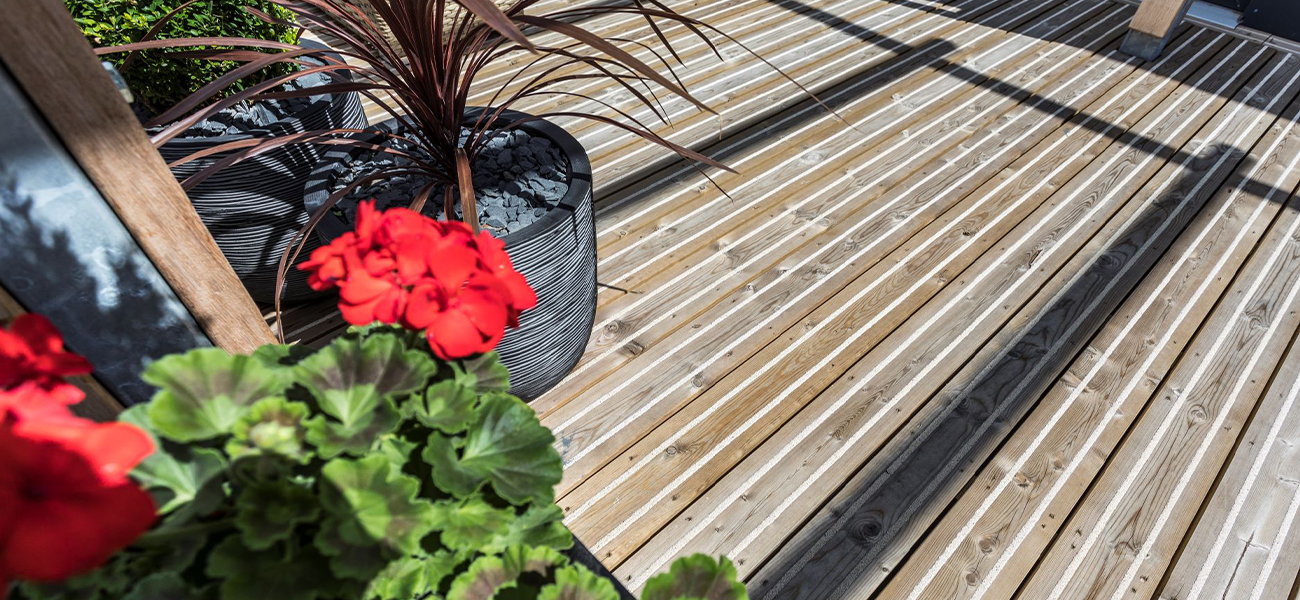Anti slip timber decking commonly asked questions

What is the life expectancy of timber deck boards?
The true life expectancy of your deck boards would depend on the application and the treatment. Good maintenance will also increase the life expectancy of your deck boards.
What’s the difference between hardwood and softwood?
Slow grown, northern European softwood is a cost effective, durable solution for a timber deck. It is relatively easy to structurally grade and for these same reasons is a good material to work with onsite. Softwood can also be more stable being less prone to distortion. Hardwood is often chosen for superior aesthetics as the colour and the grain look beautiful when first laid. As with all timber, hardwood will gently age to a silver/grey colour just the same as softwood. Hardwoods can be difficult to work with onsite but do not usually require treatment. Softwoods are preservative treated to ensure durability, and can also be treated for aesthetics reasons (such as the Classic range) or to include a fire retardant.
What are the standard anti-slip decking lengths that are available?
Marley supply all deck boards in lengths of 3.0metres to 5.7 metres in increments of 300mm. On request Marley deck boards can be precision end trimmed to exact lengths. This can speed on site production and minimise waste.
What fixings should I use?
Always use stainless steel screws; these are the optimal choice for fixing deck boards. Marley recommend A2 grade stainless steel.
Stainless Steel Grade A2 (AISI 304);
28mm Thickness No. 10 5.2mm x 63mm
34mm Thickness No. 10 5.2mm x 75mm
46mm Thickness No. 12 5.5mm x 100mm
68mm Thickness No. 12 5.5mm x 125mm
When should I ask for Use Class 4 treatment?
Best practice for decking design and installation from the TDA states that ‘Where posts and joists will be in contact with the ground only Class 4 treatment is fit for purpose – nothing else will do.’ In ground contact would also apply to joists or bearers that are used for roof decks or balconies where the bearer is permanently supported. It is important to note that any permanent feature, such as planters or hot tubs, can create a Use Class 4 situation.
Above ground applications = Use Class 3
Ground/water contact = Use Class 4 Decking
As main walkway or exit = fire retardant
What’s the best way to cut the anti-slip inserts?
It is always best to buy antislip deck boards precision end trimmed. This ensures the treatment envelope is intact and the board ends are perfectly square. The resin inserts in timber decking is hard and difficult to cut, however, the procedure for cross cutting deck boards that contain inserts follows:
At the required point mark a square line across the board using an angle grinder 125mm max, with either a 3 or 5mm thick cutting disc (stone or steel both work equally the same) plunge the spinning disc down the marked line and remove the aggregate/resin insert.
Once the insert has been removed then a hand or mechanical timber saw can cut the timber without cutting through any of the insert. The cut ends should then be coated with cut end seal.
Why should I use end coat on cut ends?
Modern timber protection methods are based on an envelope of treatment with the preservative penetrating into the designated zones with the optimal loadings. Cross cutting the timber breaks this envelope and the exposed area now must be protected. If this isn’t treated this can provide a weak point for the onset of decay. Ideally precision end trimmed boards should be used ensuring continuous protection.
To find out more about Marley Decking solutions, contact your local specialist here.